You’ll want to use vector tightening with flat-nose pliers, moving prongs in two directions to prevent springback. Number your prongs 1-4 and squeeze adjacent pairs together using a cross-pattern approach. Identify the root cause first—whether it’s poor craftsmanship, wear, or inadequate initial setting. Use proper tools like prong pushers and gemsetting pliers for precision work. Consider your metal type, as softer gold requires more frequent maintenance than platinum. Work in well-lit areas with safety equipment to protect yourself and the stones. The complete techniques below guarantee lasting results.
Understanding Vector Tightening for Prong Settings
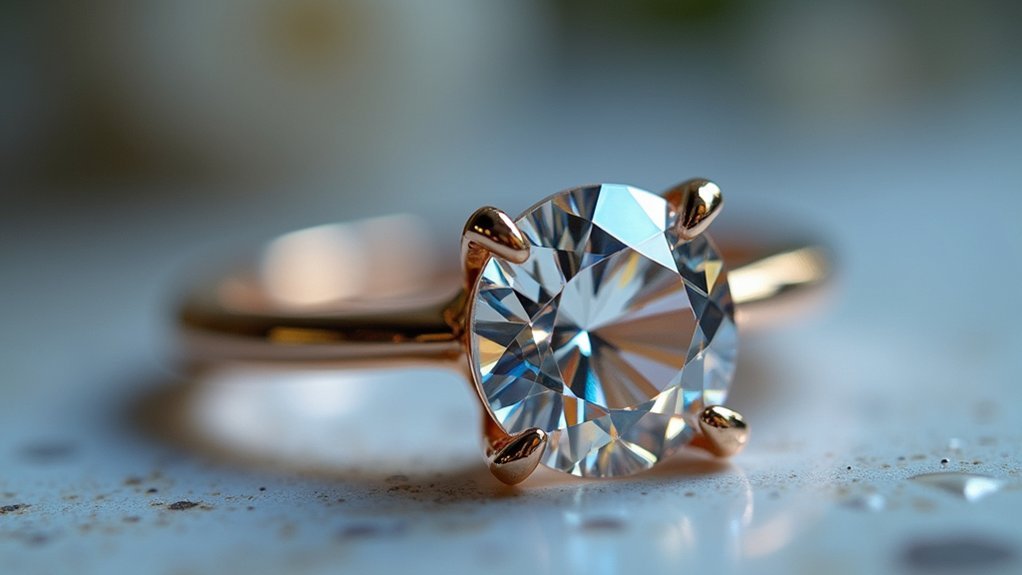
When you’re dealing with a loose stone in a prong setting, vector tightening offers a superior approach that prevents the metal memory effect that causes prongs to spring back to their original position. This technique involves moving prongs in two directions to create spring-loaded tension, securing loose stones effectively without risking breakage.
To execute vector tightening properly, you’ll squeeze adjacent prongs together—like pairing prongs 1 and 2, then 3 and 4. Use flat or chain-nose pliers to guarantee prongs align squarely to the stone after adjustment.
Always complete any necessary prebending of prong tips before performing vector tightening as your final adjustment step. Regular practice of this method enhances your efficiency while prolonging jewelry settings’ life by keeping stones securely positioned.
Identifying the Root Cause of Loose Stones
Before you can effectively tighten loose stones, you’ll need to pinpoint what’s causing the problem in the first place.
Start by examining common craftsmanship issues like poorly positioned prongs or inadequate initial tightening that may have compromised your setting from day one.
Next, look for metal wear patterns and setting-specific problems that develop over time through normal use or environmental factors.
Common Craftsmanship Issues
While identifying loose stones is important, understanding what causes them to loosen in the first place will help you prevent future problems. Common craftsmanship issues often stem from poor initial work during the setting process. When jewelers don’t properly place prongs or fail to tighten them adequately, you’ll face problems down the road.
Several factors contribute to loose stones over time:
- Improper prong placement during initial setting
- Inadequate tightening of prongs or bezels
- Using softer metals that bend easily under stress
- Poor quality control during manufacturing
You’ll notice that softer metals like gold are particularly susceptible to bending, which means they’ll require more frequent inspections.
Without regular maintenance, these initial craftsmanship flaws will worsen, eventually causing your stones to become dangerously loose.
Metal Wear Patterns
Beyond initial craftsmanship problems, metal wear patterns reveal the true story behind your loose stones. Channel settings show telltale signs of deterioration at their tops, where daily contact gradually erodes the metal holding your stones secure.
You’ll notice this wear particularly in softer metals like gold, which bend more readily under stress than harder alternatives.
Regular use creates predictable wear patterns that compromise setting integrity over time. Your jewelry’s exposure to harsh conditions accelerates these patterns, while rough handling compounds the damage.
The stones themselves also wear down, reducing their fit within settings. Without consistent inspections and maintenance, these wear patterns worsen rapidly.
You can prevent extensive damage by catching early signs of metal fatigue before your loose stones become a serious problem.
Setting Type Problems
Different setting types create unique vulnerabilities that directly contribute to stone looseness.
Channel settings are particularly susceptible because they rely on precise metalwork to hold stones securely between parallel walls. When craftsmanship falls short during the initial setting process, you’ll face inadequate support that compromises stone security from day one.
Understanding these setting-specific challenges helps you identify potential problems:
- Channel settings require exact measurements and proper tension between metal walls
- Prong settings depend on individual claw strength and positioning accuracy
- Bezel settings need consistent metal thickness around the stone perimeter
- Pave settings rely on multiple small beads working together harmoniously
You’ll notice that each setting type demands different maintenance approaches and presents distinct failure points that require targeted solutions.
Proper Tools for Stone Tightening Procedures
Having the right tools makes all the difference when you’re tightening stones in loose settings. The proper tools for stone tightening procedures include several essential items that’ll guarantee professional results.
Start with flat or chain-nose pliers for vector tightening, as they provide necessary leverage to adjust prongs without damaging your stone.
Prong pliers are vital for closing prongs over the stone—position one jaw beneath the setting while the other grips the prong’s top.
Gemsetting pliers offer another excellent option, allowing precise control for effective prong closure around your gem.
Don’t forget prong pushers for the final setting step; they’ll secure prong tips over the stone and can be gently tapped with a hammer when needed.
Always keep various burrs handy for preparing prong seats and guaranteeing secure gemstone fit.
Sequential Prong Adjustment Techniques
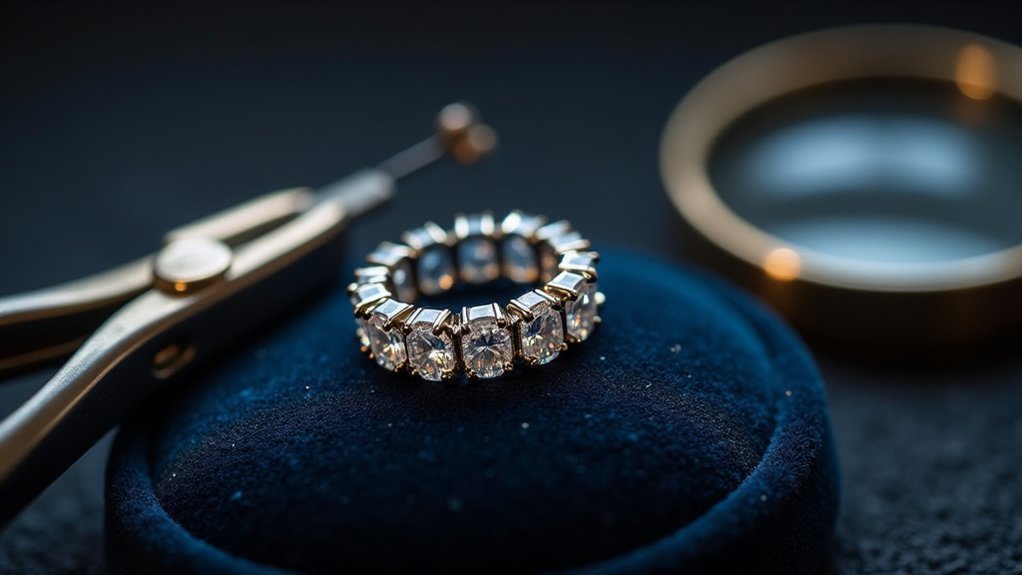
You’ll achieve the best results by following a specific sequence when adjusting prongs on four-prong settings.
Start by numbering your prongs 1 through 4, then squeeze adjacent pairs together—first prongs 1 and 2, then 3 and 4—before moving to opposite pairs for balanced tension.
This systematic approach leads naturally to vector tightening, which offers superior safety and control compared to direct pressure methods.
Vector Method Benefits
The vector tightening technique delivers multiple advantages that make it superior to random prong adjustments:
- Prevents stone breakage through controlled, alternating pressure distribution
- Eliminates springback effects by working against metal memory systematically
- Maintains prong alignment by avoiding distortion through sequential pairing
- Creates lasting tension that keeps stones secure longer than traditional methods
You’ll find this approach particularly effective because it creates spring-loaded tension in two directions simultaneously.
Regular practice enhances your efficiency, allowing you to complete adjustments faster while extending the lifespan of prong settings through proper technique application.
Proper Sequencing Order
Once you’ve understood the vector method’s benefits, proper sequencing becomes critical for successful stone tightening. Start by numbering your four prongs 1 through 4 to maintain organization throughout the process.
Follow this proper sequencing order: squeeze prongs 1 and 2 together first, then prongs 3 and 4. This creates initial tension that secures the stone effectively.
Next, repeat the sequence by squeezing prongs 1 and 4 together, followed by prongs 2 and 3. This cross-pattern approach guarantees even pressure distribution around the stone.
Work gently throughout each adjustment to prevent prong distortion or metal rippling that could compromise the setting’s integrity.
After completing the sequence, verify that prongs remain square to the stone and check spacing alignment to confirm secure placement.
Working With Different Metal Types and Their Properties
When selecting metals for jewelry settings, understanding each material’s unique properties becomes essential for successful stone tightening.
Platinum stands out for its exceptional durability and ability to maintain secure grips on stones over time. Its higher tensile strength resists deformation, requiring less frequent maintenance compared to softer metals.
Gold’s malleable nature makes it more susceptible to bending and wear, which can compromise stone security if you don’t inspect settings regularly.
Consider these metal-specific characteristics when you set stones:
- Platinum prongs hold tighter naturally due to superior strength properties
- Gold requires more frequent inspections because of its softness
- Silver and gold exhibit springiness that affects tightening techniques
- Vector tightening methods work best with metals that return to original shape
Each metal demands tailored maintenance approaches for best results.
Channel Setting Tightening Methods
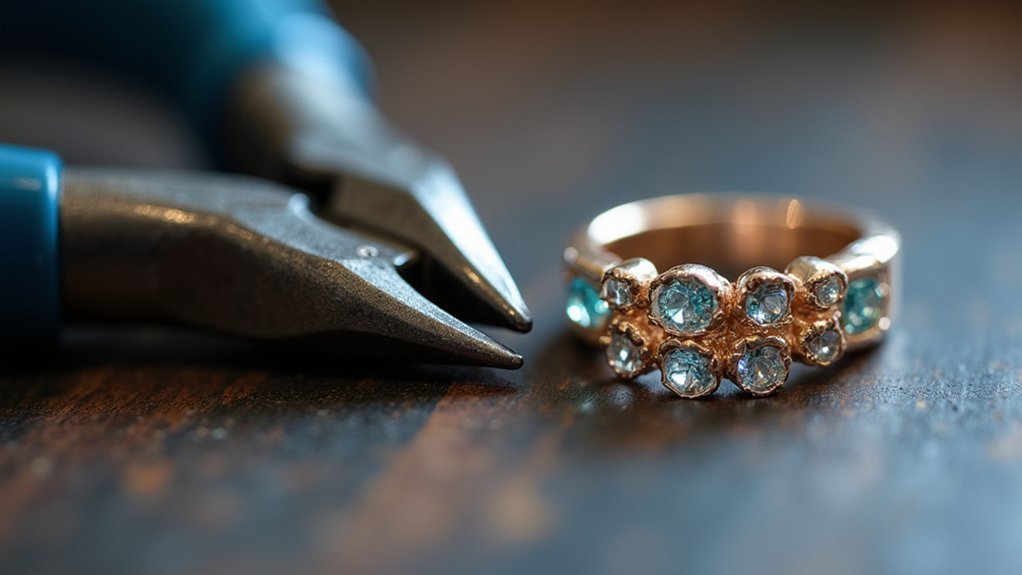
When you’re dealing with loose stones in channel settings, you’ll need to identify what’s causing the problem before applying any fix.
You can hammer the top of the channel wall to press the metal against the stone for a temporary tightening solution.
Remember that your choice of metal matters considerably—platinum naturally holds stones tighter over time compared to softer gold, which tends to bend and loosen more easily.
Common Looseness Causes
Before you can effectively tighten loose stones in channel settings, you’ll need to identify what’s causing the problem in the first place. Understanding the root cause of looseness helps you choose the most effective repair approach and prevents recurring issues.
Several factors contribute to stone looseness in channel settings:
- Poor craftsmanship – Improper fitting or inadequate securing during the original setting process
- Material choice – Softer metals like gold bend more easily than durable platinum
- Wear and tear – Daily use gradually weakens channel walls and stone seats
- Customer abuse – Impact damage or excessive force can compromise the setting integrity
You’ll want to examine each stone carefully before attempting repairs. Some looseness requires complete resetting rather than simple tightening, especially when fundamental craftsmanship issues exist.
Hammering Channel Walls
One of the most straightforward methods for tightening loose stones involves hammering the channel walls to compress the metal against the stone.
You’ll want to use gentle, controlled taps along the top edges of the channel walls to press the metal inward. This hammering technique works best when you’ve already identified the root cause of the looseness, as it may only provide temporary relief if underlying craftsmanship issues persist.
Before hammering, inspect the setting thoroughly to determine why the stone became loose initially. You can enhance the effectiveness by using pliers to squeeze the metal walls closer together after hammering.
Remember that this method works primarily for channel settings, and regular maintenance inspections will help prevent future loosening problems.
Material Durability Factors
While hammering techniques can provide immediate results, the metal you’re working with determines how long your tightening efforts will last.
Material durability factors play an essential role in how frequently you’ll need to repeat repairs and maintenance.
Platinum holds stones more securely over time due to its hardness, while gold’s malleable nature makes it prone to bending and deformation. This means your gold channel settings will require more frequent attention and tightening compared to platinum alternatives.
Consider these material durability factors when evaluating your settings:
- Gold requires more frequent maintenance due to increased malleability
- Platinum maintains tighter stone security over extended periods
- Persistent loosening may indicate deeper structural problems beyond simple settings
- Regular inspections prevent gradual wear that leads to loose stones
Choose harder metals or alloys for long-term stability.
Preparing Prong Seats for Better Stone Contact
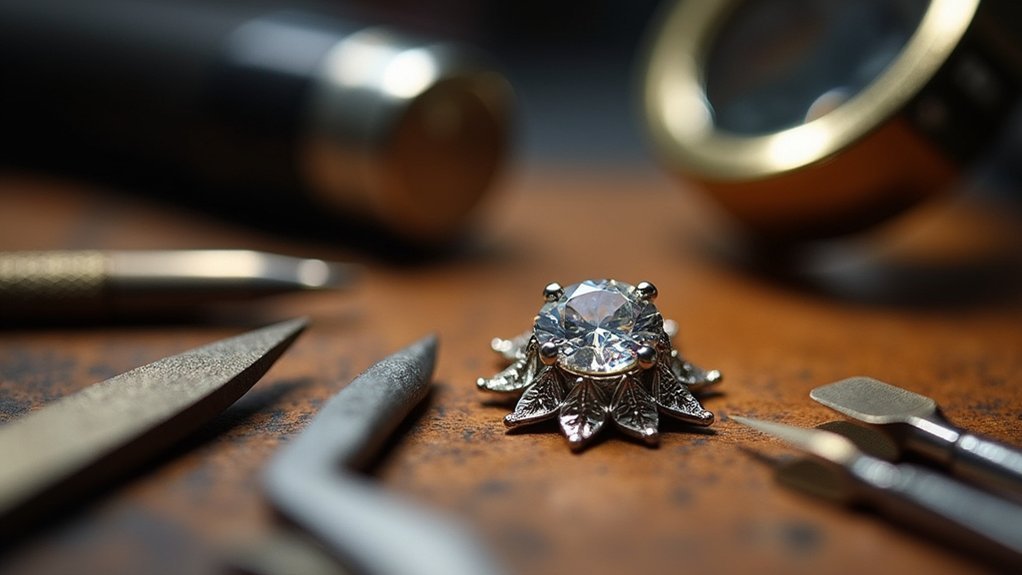
When you’re dealing with loose stones, the shape and condition of your prong seats directly determine how securely the stone will sit in its setting. You’ll need to hollow out the inner surface of each prong using a small ball burr to create better contact with your stone. This technique works especially well for heavier stones, while tiny stones typically don’t require seat adjustments.
| Stone Size | Prong Preparation | Contact Method | Security Level | Additional Notes |
|---|---|---|---|---|
| Tiny | Minimal adjustment | Standard contact | Good | Natural fit sufficient |
| Small | Light hollowing | Enhanced contact | Better | Moderate burr work |
| Medium | Standard hollowing | Improved contact | Excellent | Full seat preparation |
| Large | Deep hollowing | Maximum contact | Superior | Heavy prong benefits |
| Heavy | Complete preparation | ideal contact | Maximum | Critical for security |
Pre-bending prong tips before setting prevents accidental breakage and compensates for metal compression during the bending process.
Preventing Metal Springback During Adjustment
After you’ve properly prepared your prong seats, metal springback becomes your next major challenge in achieving lasting stone security.
Metal memory causes prongs to return to their original positions if you don’t make adjustments correctly during tightening.
Vector tightening is your most effective defense against springback. This technique involves moving prongs in two directions simultaneously, creating spring-loaded tension that prevents the metal from reverting.
Follow these essential practices to minimize springback:
- Squeeze adjacent prongs together to prevent independent movement
- Work gently to avoid distorting prongs and creating rippled metal
- Move prongs in multiple directions during each adjustment
- Perform regular inspections to catch springback issues early
Remember that rushed or aggressive tightening often worsens springback problems, so patience is vital for achieving secure, long-lasting settings.
Safety Considerations When Handling Loose Stones

Since loose stones present unique hazards during setting work, you’ll need to establish proper safety protocols before beginning any tightening procedures.
These safety considerations are fundamental to successful jewelry making and achieving good results without injury or damage.
Work in well-lit areas where you can clearly see small, reflective stones. Wear safety goggles and gloves to protect against sharp edges and tool accidents.
Create a secure workspace using trays or soft cloths to catch dropped stones and prevent them from rolling away.
Handle stones gently to avoid chipping or cracking, especially delicate gems that damage easily from minor impacts.
Watch for metal filings and debris during tightening, as these particles can injure skin or eyes if not properly managed.
Long-Term Maintenance to Prevent Future Loosening
Beyond implementing proper safety measures during repairs, establishing a thorough maintenance routine will keep your gemstone settings secure for years to come.
Regular inspections every six months help you identify early signs of loosening before they become major problems. You’ll want to choose harder metals like platinum for new settings, as they resist bending and loosening better than softer alternatives like gold.
Routine six-month inspections catch loosening early, while platinum settings outlast softer gold alternatives for superior long-term security.
Professional cleaning and vector tightening techniques during routine maintenance will secure your prongs effectively and extend your settings’ lifespan.
Consider these essential long-term maintenance practices:
- Schedule professional appraisals annually to assess setting integrity
- Avoid exposing jewelry to harsh chemicals or extreme temperatures
- Remove pieces during high-impact activities or manual labor
- Store jewelry properly in padded compartments to prevent damage
Frequently Asked Questions
How to Fix a Loose Diamond Setting?
You’ll need to examine the prongs for damage, then use vector tightening by gently squeezing adjacent prongs together in pairs. Number four-prong settings and work systematically to create spring-loaded tension.
How Do You Set a Loose Stone?
You’ll identify the setting type first, then carefully position the stone and use appropriate pliers to bend prongs securely around it, ensuring even spacing and proper tension for a stable hold.
What to Do if the Stone in Your Ring Is Loose?
First, inspect your ring’s prongs for bending or damage. You can carefully squeeze prongs with pliers using vector tightening for spring-loaded tension. If tightening doesn’t work, visit a professional jeweler immediately.
How Do You Tighten Channel Set Stones?
You’ll start by inspecting the channel for damage or bending. Carefully hammer the channel walls’ tops to press against stones, or use pliers to squeeze walls closer together for better stone seating.
In Summary
You’ll master stone tightening by understanding vector forces and identifying root causes of loosening. Use proper tools and sequential adjustment techniques while considering each metal’s unique properties. Prepare prong seats carefully and prevent springback during adjustments. Always prioritize safety when handling loose stones. With consistent maintenance practices, you’ll prevent future problems and guarantee your jewelry remains secure. These techniques will transform your stone-setting skills and give you confidence in creating lasting, professional-quality repairs.

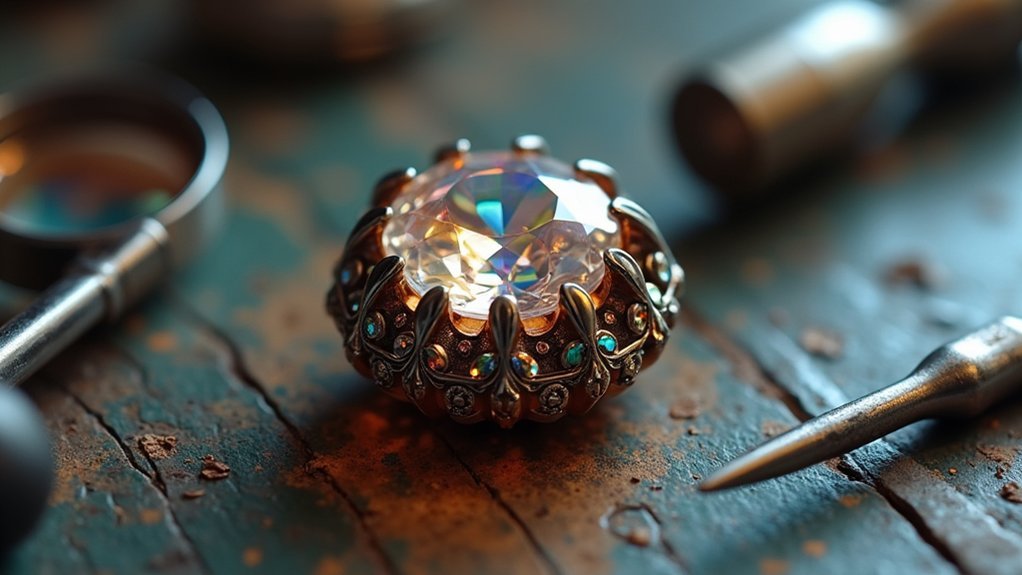



Leave a Reply